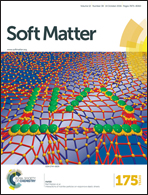Concentration-induced planar-to-homeotropic anchoring transition of stiff ring polymers on hard walls
Abstract
We study the structure and interfacial ordering of stiff ring polymers close to repulsive walls. For this purpose, we employ an anisotropic effective model in which the rings are pictured as soft, penetrable discs [P. Poier, C. N. Likos, A. J. Moreno and R. Blaak, Macromolecules, 2015, 48, 4983]. We have studied this model in the bulk and in the presence of a wall, employing Density Functional Theory and computer simulations. While the Ornstein–Zernike equation in combination with the Hypernetted Chain Approximation gives results that are in quantitative agreement with computer simulations, a simple Mean Field approximation strongly overestimates the interaction between the effective particles in the bulk. We discover that by increasing density one can induce a reorientation of the effective rings in the vicinity of a wall, which prefer to orient themselves parallel to the surface (face-on or planar) for low densities ρ and reorient orthogonal to the wall (edge-on or homeotropic) for higher values of ρ. This transition in the surface-structure can be observed in both computer simulations, as well as in an appropriate density functional theory. We trace its physical origin in the penetrable character of the rings, which allows for a reduction of the surface tension contribution due to ring–ring interactions upon the emergence of homeotropic ordering on the wall and increasing the density of the system.


 Please wait while we load your content...
Please wait while we load your content...